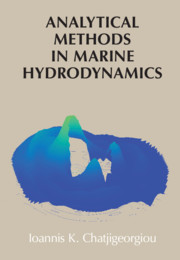Book contents
- Analytical Methods in Marine Hydrodynamics
- Dedication
- Analytical Methods in Marine Hydrodynamics
- Copyright page
- Contents
- Foreword
- Preface
- Note on Symbols and Notations
- 1 Description of the Flow
- 2 Linear Hydrodynamics of Circular Cylinders
- 3 Higher-Order Phenomena for Circular Cylinders
- 4 Hydrodynamics of Elliptical Cylinders
- 5 Hydrodynamics of Spheres and Spheroids
- 6 Hydrodynamics of Ellipsoids
- Book part
- References
- Index
4 - Hydrodynamics of Elliptical Cylinders
Published online by Cambridge University Press: 27 June 2018
- Analytical Methods in Marine Hydrodynamics
- Dedication
- Analytical Methods in Marine Hydrodynamics
- Copyright page
- Contents
- Foreword
- Preface
- Note on Symbols and Notations
- 1 Description of the Flow
- 2 Linear Hydrodynamics of Circular Cylinders
- 3 Higher-Order Phenomena for Circular Cylinders
- 4 Hydrodynamics of Elliptical Cylinders
- 5 Hydrodynamics of Spheres and Spheroids
- 6 Hydrodynamics of Ellipsoids
- Book part
- References
- Index
Summary
In structural mechanics, the term “Mathieu equation,” is almost always connected with the axial cyclic loading of beams applied at their supporting ends. In relevant situations, even in linear formulations, the axial loading associated with the curvature of the beam, produces a nonlinear term that is constructed by the time-varying function of the cyclic motion times the bending motion of the beam. This type of loading induces dynamic buckling of the beam, which accordingly could cause instabilities in its dynamic behavior. In relevant studies it is difficult to find proper clarifications that the mathematical model is not actually the Mathieu equation but the “periodic Mathieu equation” to distinguish the latter from the “modified Mathieu equation.” Indeed, the solution of the periodic Mathieu equation depends on its characteristics values, which accordingly determine the regions of stability or instability in the dynamic buckling under cyclic loading of beams.
The connection of the periodic Mathieu equation with that type of loading is accidental, as the mathematical formulation of the phenomenon under the assumption of an Euler–Bernoulli beam model simply resembles that equation. In fact, the periodic and the modified Mathieu equations arise from the separable solutions of the Laplace equation in an elliptic coordinate system. The solutions of the Mathieu equations, known as the Mathieu functions, form the elliptical harmonics, i.e., the products of the periodic and the modified Mathieu functions. Given the fact that separable solutions of the Laplace equations in the elliptical frame of reference exist, one can formulate the velocity potentials in hydrodynamical boundary value problems associated with the specific geometry.
In contrast to circular cylinders analytical studies on elliptical geometry associated with hydrodynamics are scarce, although elliptical cylinders and especially truncated could approximate to some extend the hulls of ships. This fact is not actually odd, as Mathieu functions have not been elaborated to the extent, say, Bessel functions have been in terms of asymptotics, integral representations, correlation with other special functions, addition theorems, etc. Further, existing routine software collections, including packages of symbolic languages, appear to ignore Mathieu functions.
The present chapter aims to collect and summarize the state of the art on the analytical methods employed for treating hydrodynamical boundary value problems involving elliptical cylinders. Briefly, it provides information on the Mathieu functions and their properties including several addition theorems. Also, it presents solutions for the diffraction and the radiation problems in elliptical geometry and investigates the hydrodynamic interactions between arrays of multiple elliptical cylinders, including potential trapped-mode phenomena. The theory is extended to second order and the governing Green’s function for the associated “locked” wave component is determined.
- Type
- Chapter
- Information
- Analytical Methods in Marine Hydrodynamics , pp. 177 - 237Publisher: Cambridge University PressPrint publication year: 2018



